AUDI TT ROADSTER 2015 Owners Manual
Manufacturer: AUDI, Model Year: 2015, Model line: TT ROADSTER, Model: AUDI TT ROADSTER 2015Pages: 244, PDF Size: 60.74 MB
Page 111 of 244
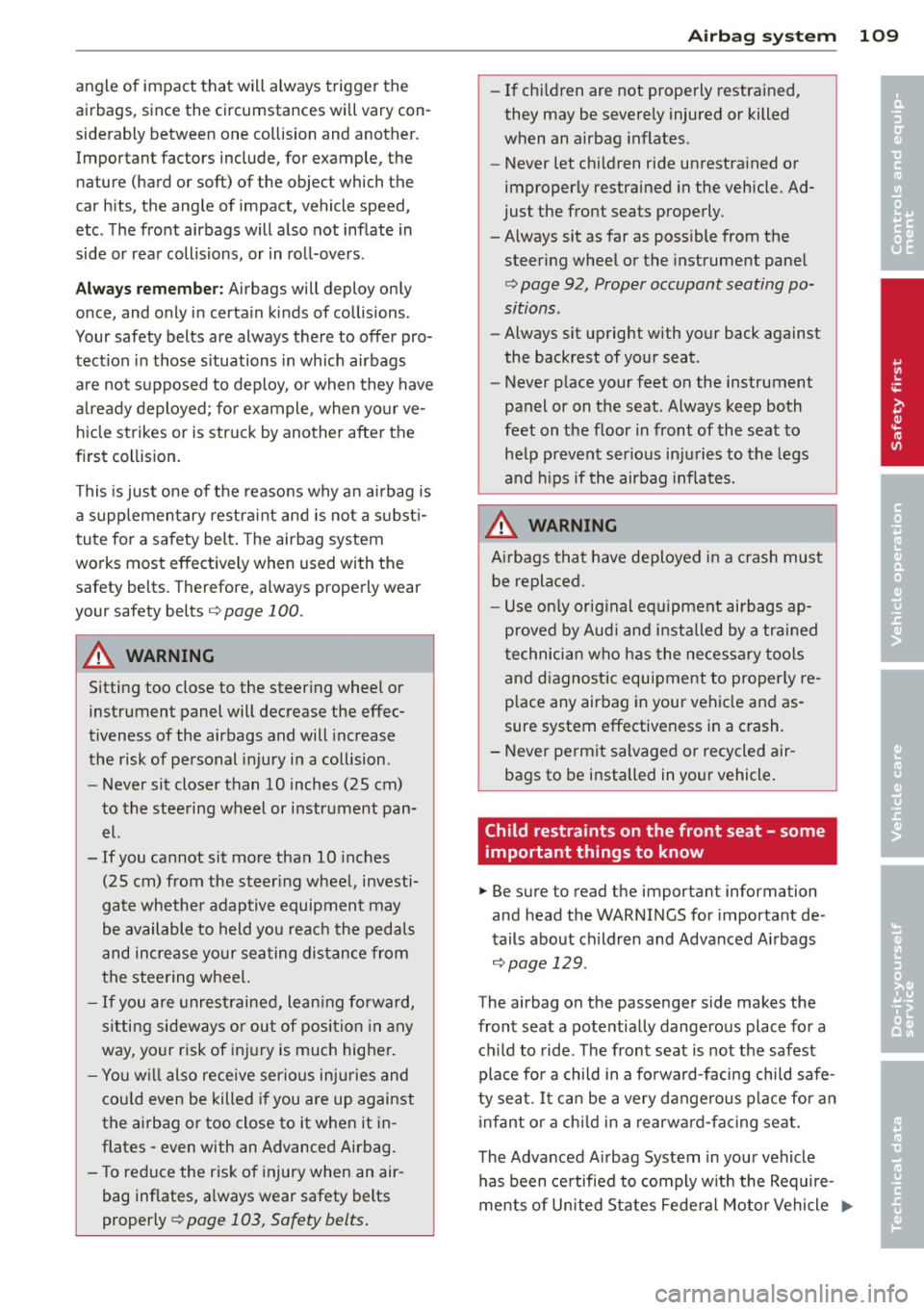
angle of impact that will always trigger the
airbags, since the circumstances will vary con
siderably between one collision and another.
Important factors include, for example, the nature (hard or soft) of the object which the
car hits, the angle of impact, vehicle speed,
etc. The front airbags will also not inflate in
side or rear collisions, or in ro ll-overs .
A lwa ys
rem ember : Airbags will deploy only
once, and only in certa in kinds of collisions .
Your safety belts are always there to offer pro
tection in those s ituations in which airbags
are not supposed to deploy , or when they have
a lready deployed ; fo r example , when yo ur ve
h icle strikes or is struck by another after the
first collision .
This is just one of the reasons why an a irbag is
a supplementary restra int and is not a s ubst i
tute for a safety belt . The airbag system
works most effectively when used with the
safety belts. Therefore, always properly wear
your safety belts
¢ page 100.
A WARNING
Sitting too close to the steer ing wheel or
instrument panel will decrease the effec
tiveness of the airbags and will increase
the risk of pe rsonal injury in a co llision .
- Never sit closer than 10 inches (25 cm)
to the stee ring wheel or instrument pan
el.
- If you cannot sit more than 10 inches
(25 cm) from the steer ing whee l, investi
gate whether adaptive equipment may
be available to held you reach the pedals
and increase your seating dis tance from
the steering wheel.
- If you are unrestrained, lean ing fo rward,
sitting sideways or out of position in any
way, yo ur risk of inj ury is much highe r.
- You w il l also receive serio us inju ries and
cou ld even be killed if you are up against
the airbag or too close to it when it in
flates -even with an Advanced Airbag.
- To reduce the r isk o f injury when an air
bag inflates, a lways wear safety belts
proper ly ¢
page 103, Safety belts .
Airbag sys tem 109
-If ch ildren are not prope rly restrained,
they may be severely injured or killed
when an airbag inflates.
- Never let ch ildren ride unrestra ined or
improperly restrained in the vehicle. Ad
just the front seats properly.
- Always sit as far as possible from the steer ing whee l or the instrument panel
¢ page 92, Proper occupant seating po
sitions.
- Always sit upright with your back against
the backrest of your seat.
- Never p lace your feet on the instrument
panel or on t he seat. Always keep both
feet on the f loor in front of the seat to
help prevent serious in ju ries to the legs
a nd hips if the airbag inflates.
A WARNING
A irbags that have deployed in a crash must
be replaced.
- Use on ly orig inal equipment airbags ap
proved by Aud i and i nstalled by a trai ned
technician who has the ne cessary too ls
and d iagnost ic equipment to properly re
place any airbag in your vehicle and as
sure system effectiveness in a crash.
- Never perm it salvaged or recycled air
bags to be installed in you r vehicle .
Child restraints on the front seat - some
important things to know
.. Be s ure to read the important in forma tion
and head the WARNINGS for important de
tails about ch ildren and Advanced A irbags
¢ page 129.
The airbag on the passenger side makes the
front seat a pote ntially dange rous place for a
c hi ld to ride . The front seat is not the safest
pla ce for a child in a fo rward-facing child safe
ty seat.
It can be a very d angerous place for a n
infant or a chi ld in a rearwa rd -fa cing seat.
The Advanced A irbag System in you r vehicle
has been ce rtified to comply wit h the Require
ments of United States Fede ral Motor Vehicle
1111>
•
•
Page 112 of 244
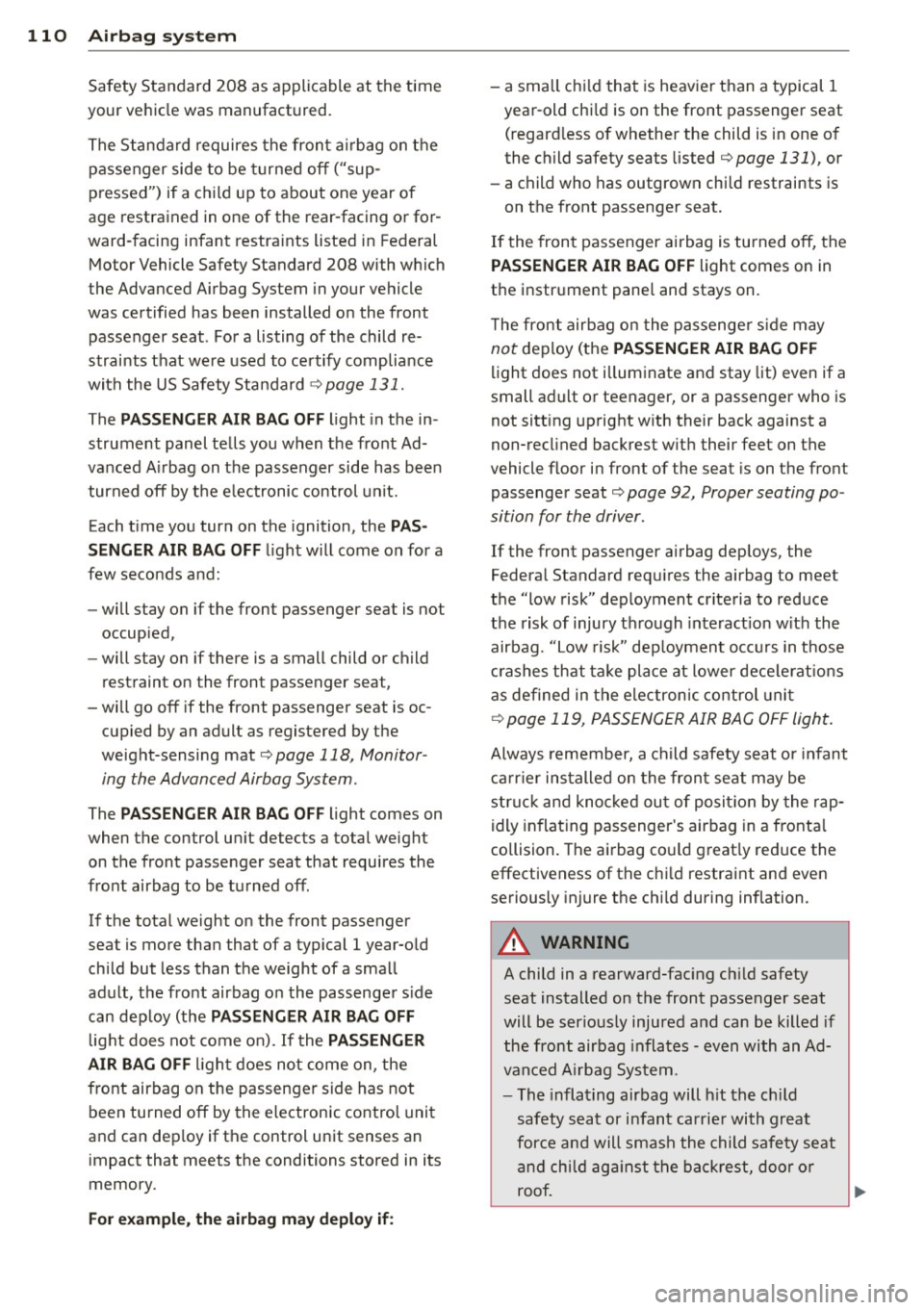
110 Airbag sys te m
Safety Standard 208 as applicable at the time
your vehicle was manufactured.
The Standard requires the front a irbag on t he
passenger side to be turned off ("sup
pressed") if a child up to about one year of
age restrained in one of the rear-facing or for
ward -facing infant restra ints listed in Federal
Motor Vehicle Safety Standard 208 with which
the Advanced A irbag System in your vehicle
was certified has been installed on the front passenger seat . For a listing of the child re
straints that were used to certify compliance
with the US Safety Standard¢
page 131.
The PASSENG ER AIR BAG OFF light in the in
strument panel tells you when the front Ad
vanced A irbag on the passenger side has been
turned off by the e lectronic control unit.
Each t ime you turn on the ignition, the
PAS
SENGER AIR BA G OFF
light w ill come on for a
few seconds and:
- will stay on if the front passenger seat is not
occupied,
- will stay on if there is a small child or child
restraint on the front passenger seat,
- wi ll go off if the front passenger seat is oc
cupied by an adult as registered by the
weight-sensing mat
¢ page 118, Monitor
ing the Advanced Airbag System .
The PASSEN GER AIR BAG OFF light comes on
when the control un it detects a total weight
on the front passenger seat that requires the
front airbag to be turned off .
If the tota l weight on the front passenger
seat is more than that of a typical 1 year-old
child but less than the weight of a small
adult, t he front airbag on the passenger s ide
can dep loy (the
PAS SENGER AIR BAG OFF
light does not come o n). If the PASSENGER
AIR BAG OFF
l igh t does not come on , the
front airbag on the passenger side has not
been turned off by the electronic control unit
and can dep loy if the control unit senses an
impact that meets the conditions stored in its
memory .
For example , the airb ag ma y depl oy if :
- a small ch ild tha t is heav ier than a typical 1
year-old chi ld is on the front passenger seat
(regard less of whether the child is in one of
the child safety seats listed
¢ page 131), or
- a child who has outgrown child restraints is
on the front passenger seat.
If the front passenger airbag is turned off, the
PASSENGER AIR BAG OFF light comes on in
t h e instr ument pane l and stays on.
T he front airbag on the passenge r side may
not dep loy (the PASSENGER AIR BAG OFF
li ght does not illum inate and stay lit) even if a
small adult or teenager, or a passenger who is
not sitt ing upright w ith their back against a
non-recl ined backrest w it h their feet on the
vehicle floor in front of the seat is on the front
passenger seat¢
page 92, Proper seating po
sition for the driver .
If the front passenger airbag deploys, the
Federal Standard requ ires the airbag to meet
the "low risk" deployment cr iteria to reduce
the risk of injury th rough interact ion w ith the
airbag. "Low risk" deployment occurs in those
crashes that ta ke pla ce at lower dece le rat io ns
as de fined in t he electronic control uni t
¢ page 119, PASSENGER AIR BAG OFF light.
Always remember, a child safety seat or infant
ca rrier in stalled on the fron t seat may be
stru ck and knoc ked out of posit ion by the rap
idly in flat ing passenger 's airbag in a fronta l
collision. The a irbag co uld great ly red uce the
effectiveness of the ch ild restraint and even
seriously in jure the chi ld during inflation .
A WARNING
-
A child in a rearward-fac ing ch ild safety
seat installed on the front passenger seat
will be serious ly injured and can be killed if
the front airbag inflates -even with an Ad
van ced A irbag System.
- The inflating airbag will h it the ch ild
safety seat or infant carrie r with great
for ce and will smash the child safety seat
a nd child ag ai nst t he backrest, door or
roof.
Page 113 of 244
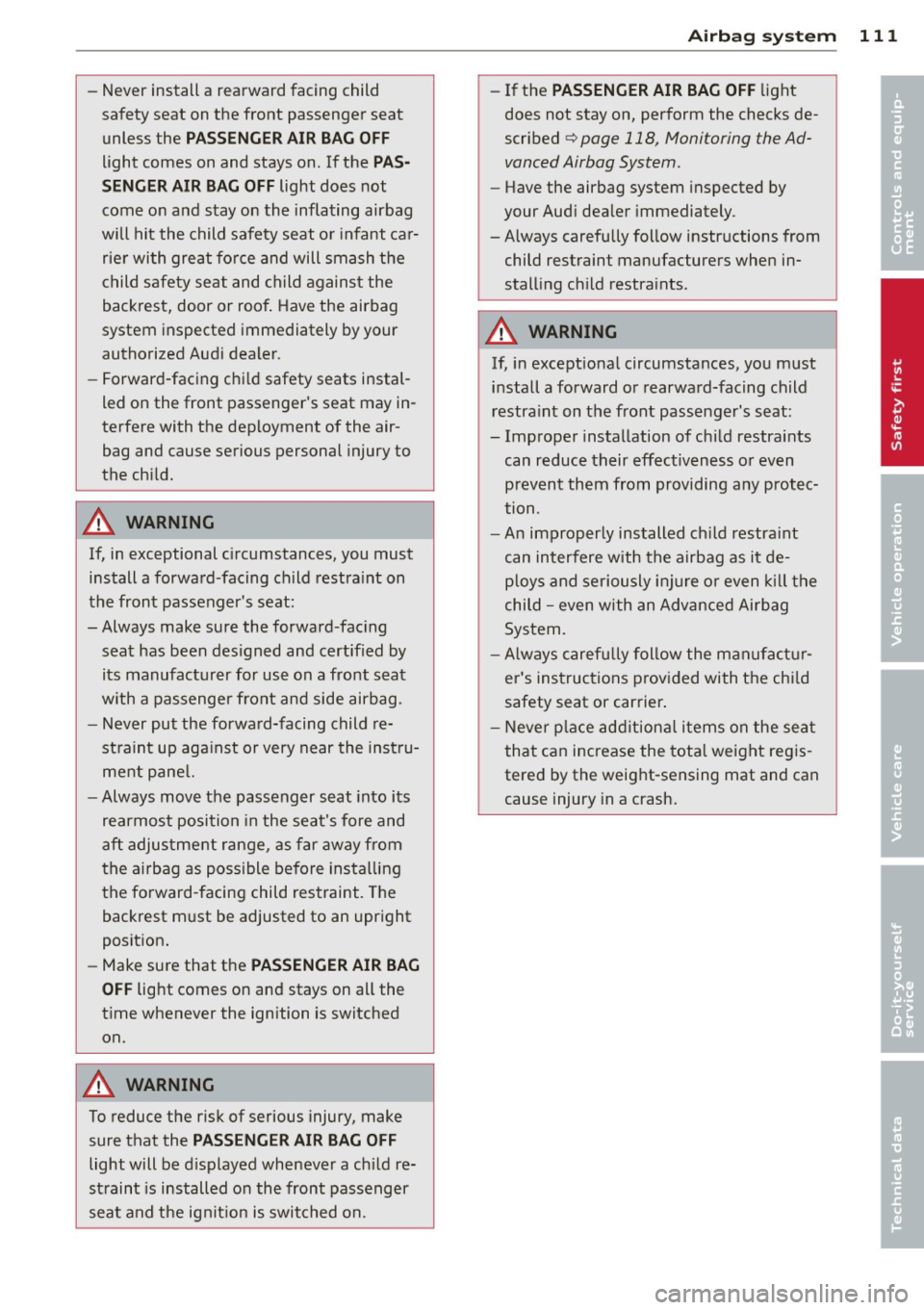
-Never install a rearward facing child
safety seat on the front passenger seat
unless the
PAS SEN GER AIR BAG OFF
light comes on and stays on. If the PA S
SEN GER AIR BA G OFF
light does not
com e on an d stay on th e inflating airbag
will hit the child safety seat or inf ant ca r
rier with great force and will smash the
child safety seat and child against the
backrest, door or roof . Have the airbag
system inspected immediately by your
authorized Audi dealer .
- Forward-facing chi ld safety seats instal
led on the front passenger's seat may in
terfere with the deployment of the air bag and cause serious personal injury to
the ch ild.
A WARNING
If, in exceptional c ircumstances, you must
install a forward-facing child restra int on
the front passenger's seat:
- Always make sure the forward-fac ing
seat has been des igned and certified by
its manufacturer for use on a front seat
with a passenger front and side airbag.
- Never put the forward-facing child re
straint up aga inst or very near the instru
ment pane l.
- Always move the passenger seat into its
rearmost position in the seat's fore and
aft adjus tment range, as far away from
the a irbag as poss ible be fore installing
the forward -facing child restraint. The
backrest m ust be adjusted to an upright
posit ion.
- Make sure that the
PASSENGER AIR BAG
OFF
light comes on and stays on all the
t ime whenever the ignition is switched
on.
A WARNING
To reduce the risk of serious injury, make sure that the
PASSENGER AIR BAG OFF
light will be d isplayed whenever a ch ild re
st raint is installed on the front passenger
seat and the ig nit io n is switched on.
A irbag system 11 1
-If the PASSENGER AIR BAG OF F light
does not stay on, perform the checks de
scribed
c> page 118, Monitoring the Ad
vanced Airbag System .
-Have the airbag system inspected by
your Aud i dea ler immediately.
-Always carefully follow instructions from
child restraint manufacturers when in
stalling ch ild restra ints .
A WARNING
--=
If, in except ional circumstances, you must
install a forward o r rearward-facing child
restra int on the front passenger's seat:
- Improper installation of ch ild restraints
can reduce their effectiveness or even prevent them from providing any protec
tion.
- An improperly installed ch ild restra int
can interfere with the airbag as it de
ploys and seriously inj ure o r even kill the
child -even with an Advanced Airbag
System.
- Always carefu lly follow the manu fact ur
er 's ins truc tions p rov ided with the chi ld
safety seat or carrier .
- Never p lace ad dition al items on the seat
that can increase the total weight reg is
tered by the weight-sensing mat and can cause injury in a crash.
•
•
Page 114 of 244
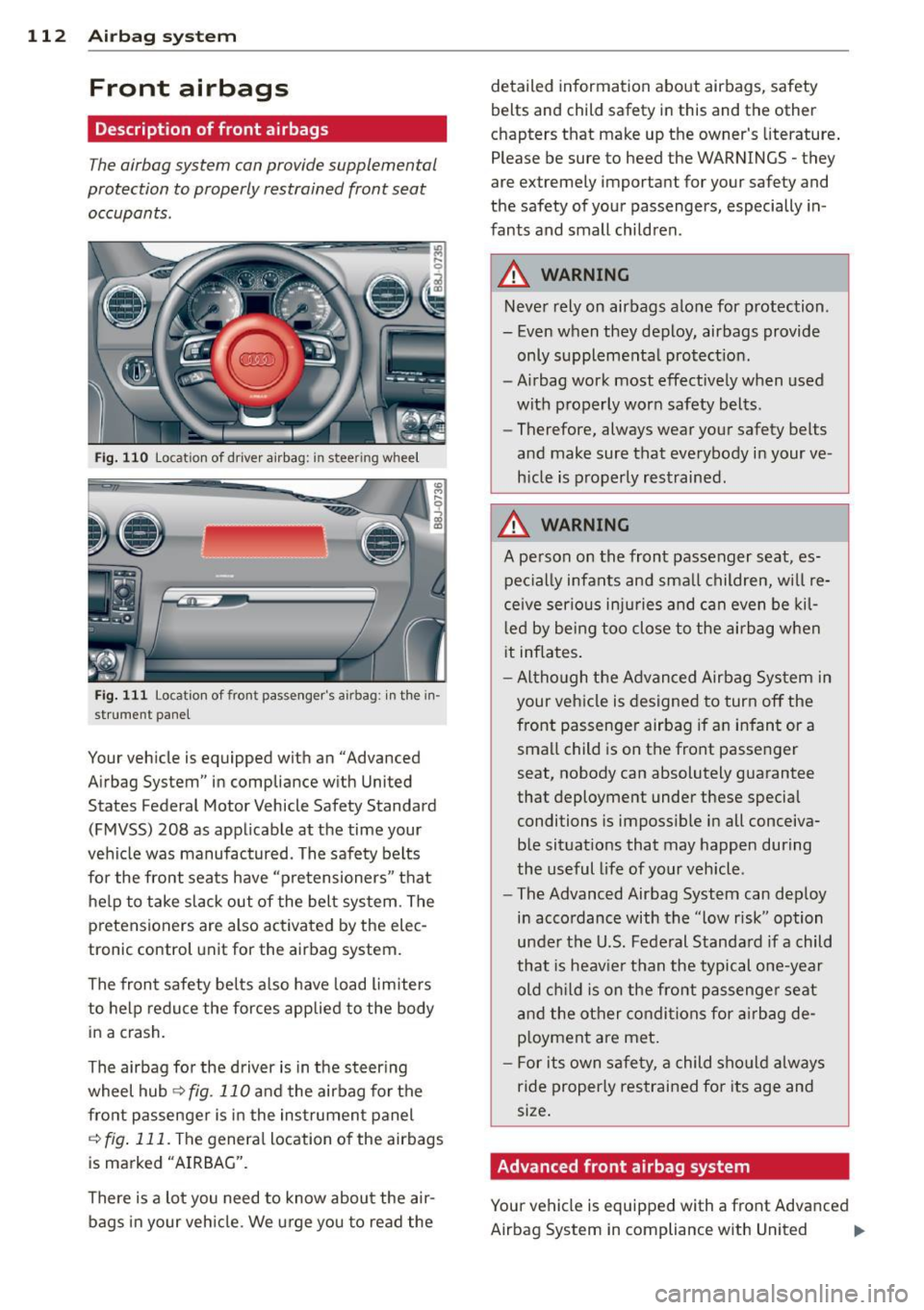
112 Airbag system
Front airbags
Description of front airbags
The airbag system can provide supplemental
protection to properly restrained front seat occupants.
Fig . 110 Locat ion of driver airbag: in steering wheel
Fig. 111 Locatio n of front passenger 's ai rbag: in t he in·
strument panel
Your vehicle is equipped with an "Advanced
Airbag System" in compliance with United
States Federal Motor Vehicle Safety Standard
(FMVSS) 208 as applicable at the time your
vehicle was manufactured . The safety belts
for the front seats have "pretensioners" that
help to take slack out of the belt system. The
pretensioners are also activated by the elec·
tronic control unit for the airbag system.
The front safety belts also have load limiters
to help reduce the forces applied to the body in a crash.
The airbag for the driver is in the steer ing
wheel hub ¢
fig. 110 and the airbag for the
front passenger is in the instrument panel
¢
fig . 111. The general location of the airbags
is marked "AIRBAG".
There is a lot you need to know about the air
bags in your vehicle. We urge you to read the detailed information abo
ut airbags, safety
belts and child safety in this and the other
chapters that make up the owner's literature .
P lease be sure to heed the WARNINGS -they
are extremely important for your safety and
the safety of your passengers, especially in
fants and small children .
A WARNING
Never rely on airbags alone for protection .
- Even when they deploy, airbags provide only supplemental protect ion.
- Airbag work most effective ly when used
with properly worn safety belts.
- Therefore, always wear your safety belts
and make sure that eve rybody in your ve
h icle is p roperly restrained.
A WARNING
A person on the front passenger seat, es
pec ially infants and sma ll children, w ill re
ceive serious injuries and can even be kil
l ed by be ing too close to the airbag when
i t inflates .
- Al tho ugh the Advanced Airbag System in
your veh icle is designed to tur n
off the
front passenger airbag if an infant or a
small child is on the front passenger
seat, nobody can absolutely guarantee
that deployment under these special
conditions is impossible in all conceiva
b le situations that may happen during
the useful life of your vehicle .
- The Advanced Airbag System can dep loy
in accordance with the "low risk" option
under the U.S . Federal Standa rd if a child
that is heav ie r th an the typical one-year
old ch ild is on the front passenger seat
and the other condi tions for a irbag de
p loyment are met .
- F or its own safe ty, a child sho uld always
ride properly restrained for its age and
size .
Advanced front airbag system
-
Your vehicle is equipped with a front Advanced
Airbag System in compliance with United ..,_
Page 115 of 244
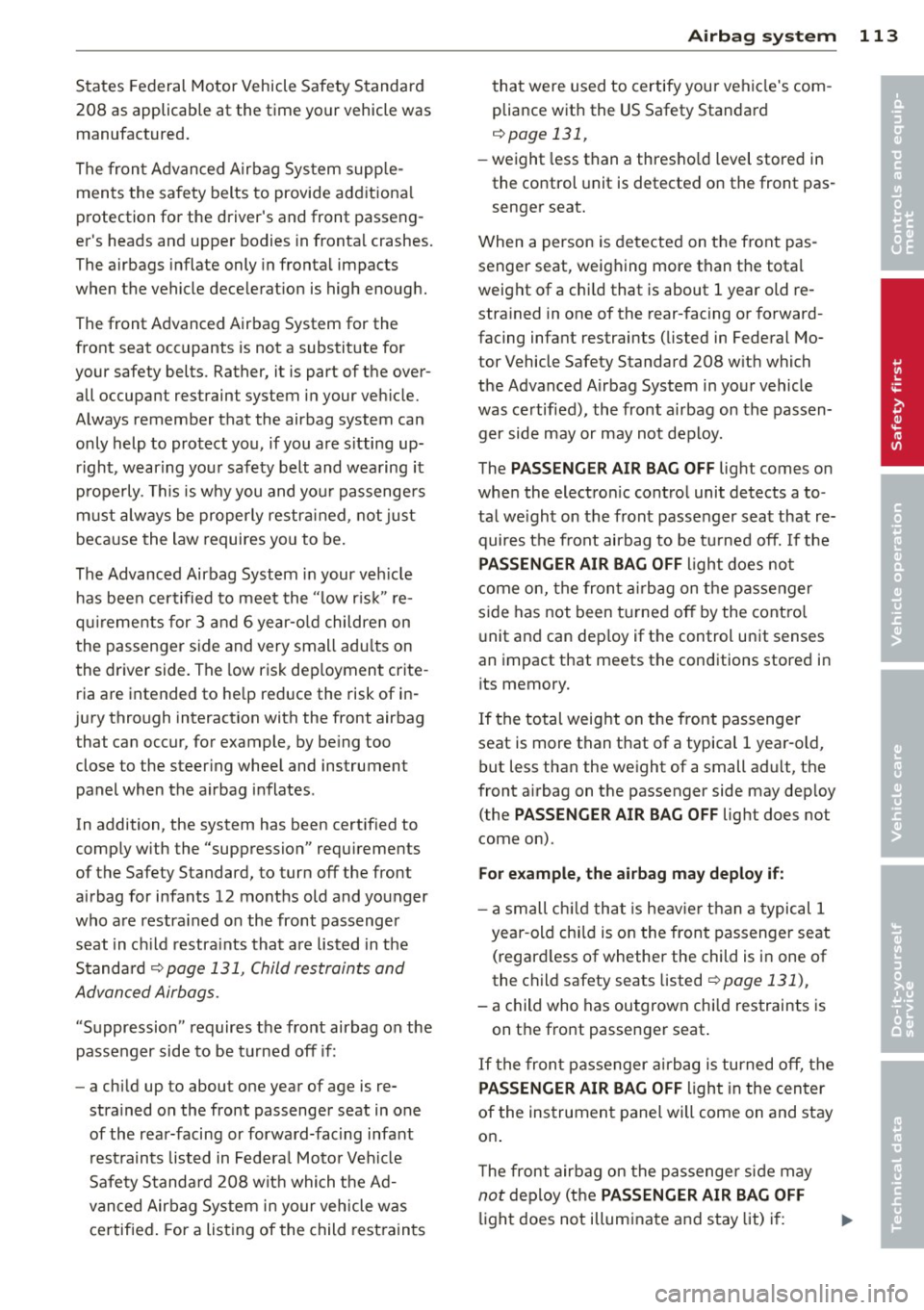
States Federal Motor Vehicle Safety Standard
208 as applicable at the time your vehicle was
manufactured.
The front Advanced A irbag System supp le
ments the safety belts to provide additiona l
protection for the driver's and front passeng
er's heads and upper bodies in fronta l crashes.
The airbags inflate only in frontal impacts
when the vehicle deceleration is high enough.
The front Advanced Airbag System for the
front seat occupants is not a substitute for
your safety belts. Rather, it is part of the over all occupant restraint system in your veh icle.
Always remember that the airbag system can
only help to protect you, if you are s itting up
right, wearing your safety belt and wea ring it
prope rly. This is why you and you r passenge rs
must always be properly restr ained , not just
because the law requires yo u to be.
The Advanced Airbag System in your veh icle
h as been certified to meet the "low ris k" re
qu irements for
3 and 6 year-o ld childre n on
the passenger side and very small adu lts on
the driver side. The low risk dep loyment crite
ria are intended to he lp reduce the risk of in
jury through interaction with the front airbag that can occur, for example, by be ing too
close to the steer ing wheel and instrument
panel when the airbag inflates.
In addition, the system has been certif ied to
comply w ith the "suppression" requ irements
of the Safety Standard, to turn
off the front
airbag for infants
12 months old and younger
who are restra ined o n the front passenger
seat in c hild restra ints that a re listed in the
Standa rd
¢page 131, Child restraints and
Advanced Airbags.
"Suppression" requires the front airbag on the passenger side to be turned
off i f:
- a ch ild up to about one year of age is re
stra ined on the front passenger seat in one
of the rear-facing or forward-fac ing infant
rest raints listed in Federa l Motor Veh icle
Safe ty S tanda rd 208 w it h which t he Ad
vanced Airbag System in your vehicle was certified . For a listing of the child rest raints
A irbag system 113
that were used to certify your vehicle's com
pliance with the US Safety Standard
¢ page 131,
-weight less than a thresho ld level stored in
the control unit is detected on the front pas
senger seat.
When a person is detected on the front pas
senger seat, weighing more than the total
weight of a chi ld that is about
1 year old re
stra ined in one of the rear-facing or forward
facing infant restraints (listed in Federal Mo
tor Vehicle Safety Standard 208 w ith which
the Advanced A irbag System in your vehicle
was certified), the front airbag on the passen ger side may or may not deploy.
The
PAS SENGER AIR BAG OFF lig ht comes on
when the electron ic contro l unit detects a to
ta l we ight on the front passenger seat that re
quires the front airbag to be tu rned
off. If the
PASSENGER AIR BAG OFF light does no t
come on, the fron t ai rbag on the passe nger
s ide has not been t urned
off by the contro l
u nit and can dep loy if the control unit senses
an impact that meets the cond itions stored in
its memory.
If the total weight on the front passenge r
seat is more than that of a typical
1 year-o ld,
but less than the we ight of a small ad ult, the
front a irbag on the passenger side may dep loy
(the
PASSENGER AIR BAG OFF light does not
come on) .
For example , the airb ag m ay deploy if:
- a small ch ild that is heav ier t han a typical 1
year -old chi ld is on the front passenger seat
(regard less of whether the child is in one of
the child safety seats listed
¢page 131),
-a child who has outgrown chi ld restraints is
on the front passenger seat .
If the fron t passenger airbag is turned
off, the
PASSENGER AIR BAG OFF light in the cen ter
of the instrument panel will come on and stay
on .
T he front airbag on the passenge r side may
not deploy (the PASSENGER AIR BAG OFF
light does not illuminate and stay lit) i f:
•
•
Page 116 of 244
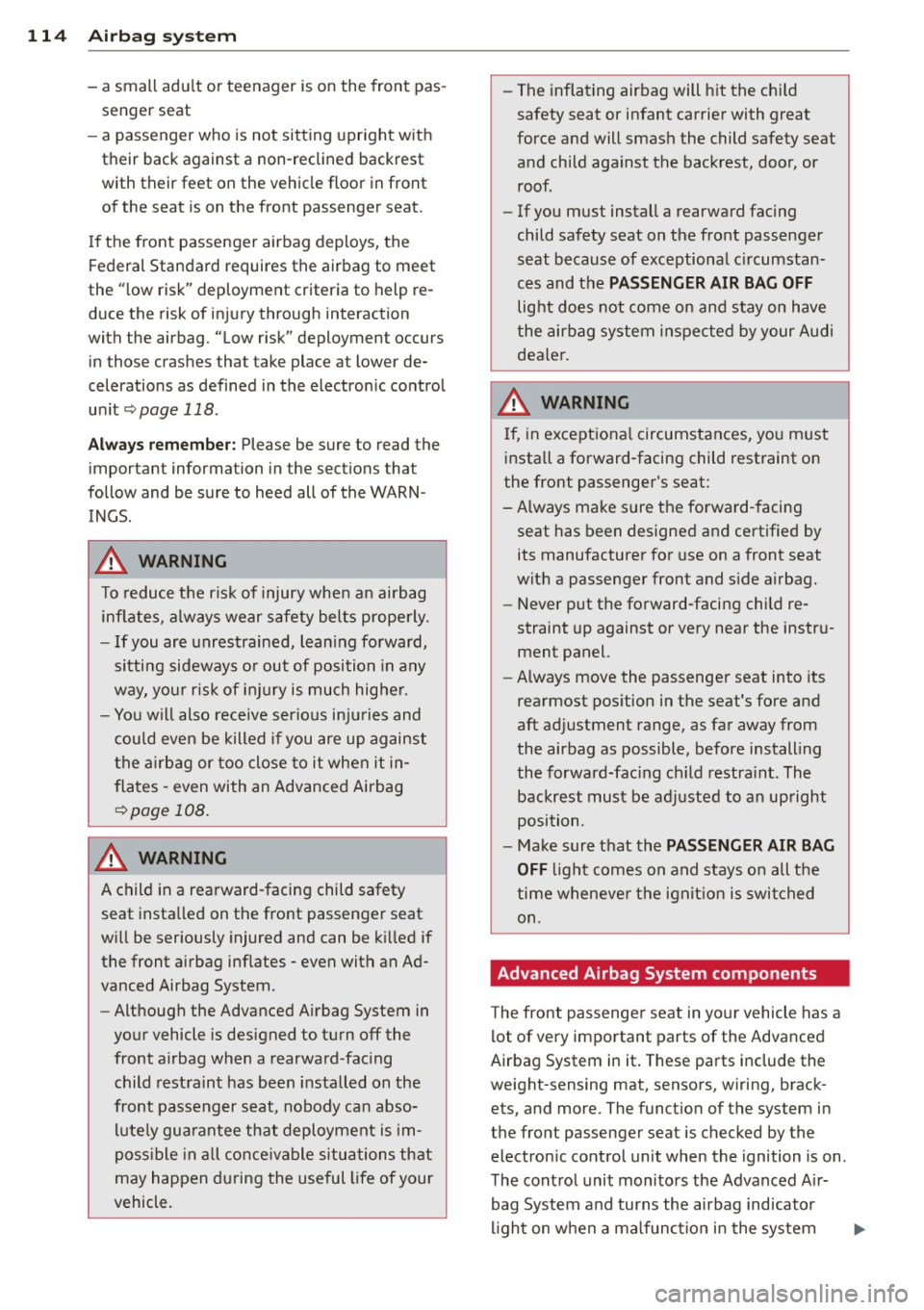
114 Airbag sys te m
- a small adu lt or teenager is on the front pas
senger seat
- a passenger who is not sitting upright with
their back against a non-reclined backrest
with their feet on the vehicle floor in front
of the seat is on the front passenger seat.
I f the front passenger airbag deploys, the
Federal Standard requires the airbag to meet
the " low risk" deployment criteria to help re
duce the risk of in jury through interaction
with the airbag . "Low risk" deployment occurs
in those cr ashes that take place at lower de
celerations as defined in the electronic control un it
Q page 118 .
Always rem ember : Please be sure to read the
impor tant informa tion in the sections tha t
follow and be sure to heed all of the WARN
INGS .
A WARNING
To reduce the r isk of injury when an airbag
inf lates , a lways wear safety belts prope rly.
- If you are unrestrained, lean ing forward,
sitting sideways or out of position in any
way, your risk of in jury is much higher.
- You w ill also receive serious inju ries and
cou ld even be killed if you are up against
the a irbag or too close to it whe n it in
flates - even with an Advanced Airbag
Q page 108.
A WARNING
-
A child in a rearward-facing child safety
seat insta lled on the front passenger seat
w ill be seriously injured and can be k illed if
the front a irbag inflates - even with an Ad
vanced Airbag System .
- Although the Advanced A irbag System in
your vehicle is designed to turn off the
front a irbag when a rearward -fac ing
child restraint has been installed on the
front passenger seat, nobody can abso l u te ly guarantee that deployment is im
poss ible in a ll conce ivable situations th at
may happen d uring the useful life of your
vehicle. -
The inflating airbag will h it the ch ild
safety seat or infant carrier with great
force and will smash the child safety seat and child aga inst the backrest, door, or
roof.
- If you must install a rearward fac ing
child safety seat on the front passenger
seat because of exceptiona l circumstan
ces and t he
PASSENGER AIR BAG OFF
light does not come on and s tay on have
the airbag system inspecte d by your Audi
dealer.
A WARNING
--=
If, in exceptiona l circumstances, you m ust
i nstall a forward -facing child restraint on
the front passenger's seat:
- Always make sure the forward- facing
seat has been designed and certified by
its manufacturer for use on a front seat
wit h a passenger front and s ide a irbag.
- Never p ut the fo rward-facing chi ld re
straint up against or very near the instru
ment panel.
- Always move the passenger seat into its
rea rmost pos ition in the seat's fore and
aft ad justment range, as far away from
the airbag as possible, before install ing
the forward-fac ing ch ild restra int . The
backrest must be ad justed to an up right
position.
- Make sure that the
PASSENGER AIR BAG
OFF
li ght comes on a nd stays o n all the
time wheneve r the ignit ion is switched
on .
Advanced Airbag System components
The front passenge r seat in yo ur vehicle has a
lot of very important parts of the Advanced
Airbag System in it . These parts i nclude the
weight-sensing mat, sensors, wiring, brack ets, and more. The funct ion of the system in
the front passenger seat is checked by the electron ic control unit when the ignition is on .
The cont rol unit monito rs the Advanced A ir
bag System and turns the airbag indicato r
li ght on w hen a malfun ct io n in t he system
Page 117 of 244
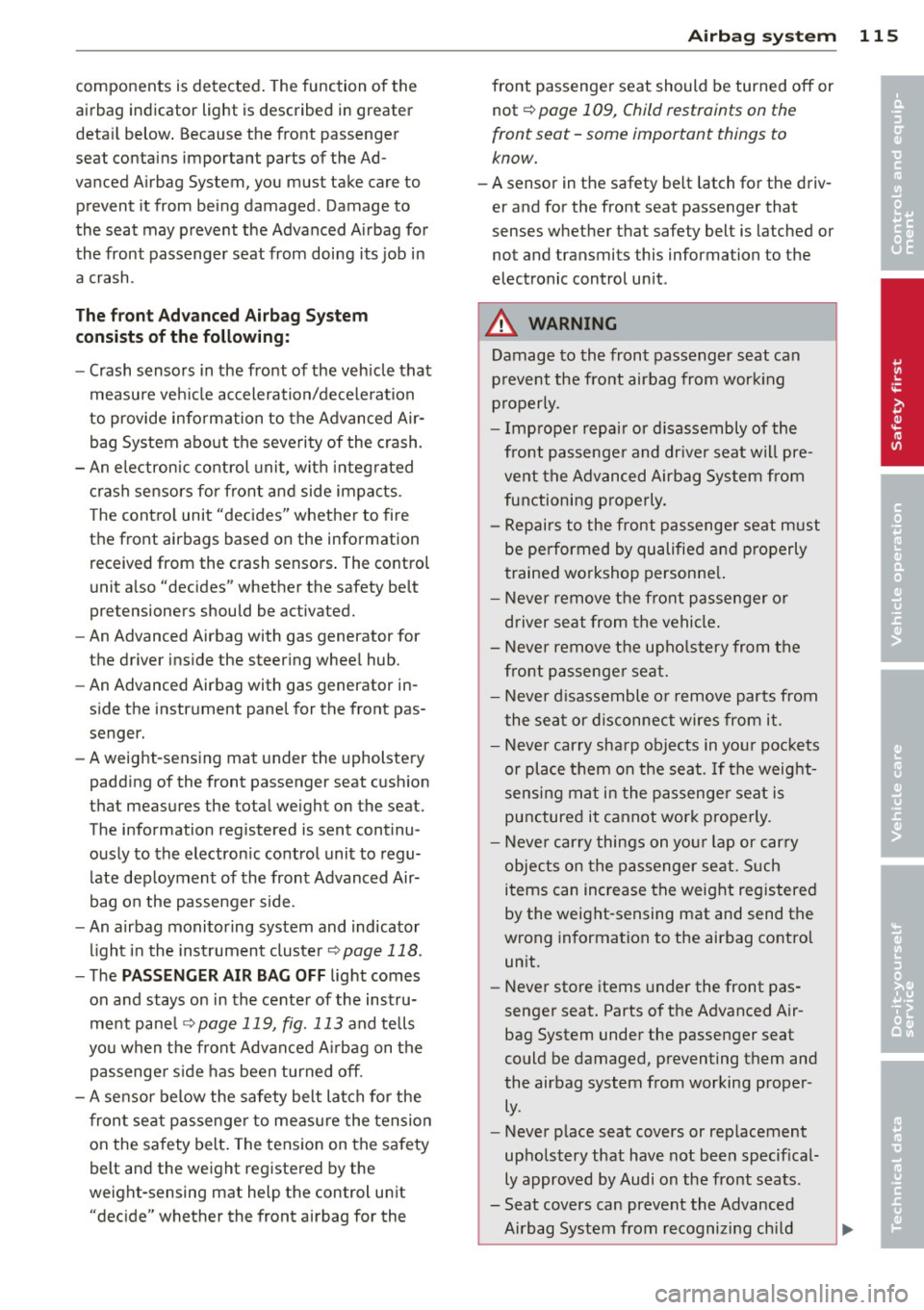
components is detected . The function of the
airbag indicator light is described in greater
deta il below . Because the front passenger
seat contains important parts of the Ad
vanced Airbag System, you must take care to
prevent it from being damaged. Damage to
the seat may prevent the Advanced A irbag for
the front passenger seat from doing its job in
a crash.
The f ront Ad vanc ed Airb ag S ystem
consists of the following:
- Crash sensors in the front of the veh icle that
measu re ve hicle acceleration/deceleration
to provide information to the Advanced Air
bag System about the severity of the crash.
- An electronic control unit, with integrated
c rash sensors for front and side impacts.
T he contro l unit "decides" whether to fire
the front airbags based on the information
received from the crash sensors . The control
unit also "decides" whether the safety belt
pretensioners should be activated.
- An Advanced Airbag with gas generator for
the driver ins ide the steer ing wheel hub.
- An Advanced Airbag with gas generator in
side the instr ument panel for the front pas
senger.
- A weight-sensing mat under the upholstery
padding of the front passenger seat cushion
that measures the total weight on the seat.
The information registered is sent continu
ously to the electron ic control unit to regu
late dep loyment of the front Advanced Air
bag on the passenger side.
- An a irbag monitoring system and indicator
li ght in the instrument cluster
¢page 118.
-The PASSENGER AIR BAG OFF light comes
on and stays on in the center of the instru
ment pane l
¢page 119, fig. 113 and te lls
you when the front Adv anced Airbag on the
passenge r side has been turned off.
- A senso r below the safety belt latch for the
front seat passenger to me asure the tension
on the safety belt . The tens ion on the safety
belt and the weight registered by the
weight-sensing mat help the control unit
"dec ide" whether the front airbag for the
Airbag system 11 5
front passenger seat should be turned off or
not
¢ page 109, Child restraints on the
front seat -some important things to
know.
- A sensor in the safety belt latch for the driv
er and for the front seat passenger that
senses whether that safety belt is latched or
not and transmits this information to the
electronic control unit .
.&, WARNING
Damage to the front passenger seat can
prevent the front airbag from wor king
properly.
- Improper repai r or d isassembly of the
front passenge r and dr iver seat will pre
vent the Advanced Airbag System from
functioning properly.
- Repairs to the front passenge r seat must
be pe rformed by qualified and p roperly
trained workshop personne l.
- Never remove the front passenger o r
driver seat from the vehicle .
- Never remove the upholstery from the
front passenger seat.
- Neve r d isassemble o r remove parts from
the seat or disconnec t wires from it.
- Never carry sharp objects in you r pockets
or place t hem on the seat. If the weight
sens ing ma t in the passenge r seat is
punctured it cannot work properly .
- Neve r carry things on you r lap or carry
objects on the passenger seat. Such
items can increase the weight registered
by the weight-sensing mat and send the
wrong information to the airbag co ntrol
un it.
- Never store items under the front pas
senger seat. Parts o f the Advanced Air
bag System under the passenger seat
could be damaged, preventing them and
the airbag system from working proper ly.
- Never p lace seat covers or rep lacement
upholstery that have not been specifica l
ly approved by Audi on the front seats.
- Seat covers can prevent the Advanced
Airbag System from recognizing chi ld
Ill>
•
•
Page 118 of 244
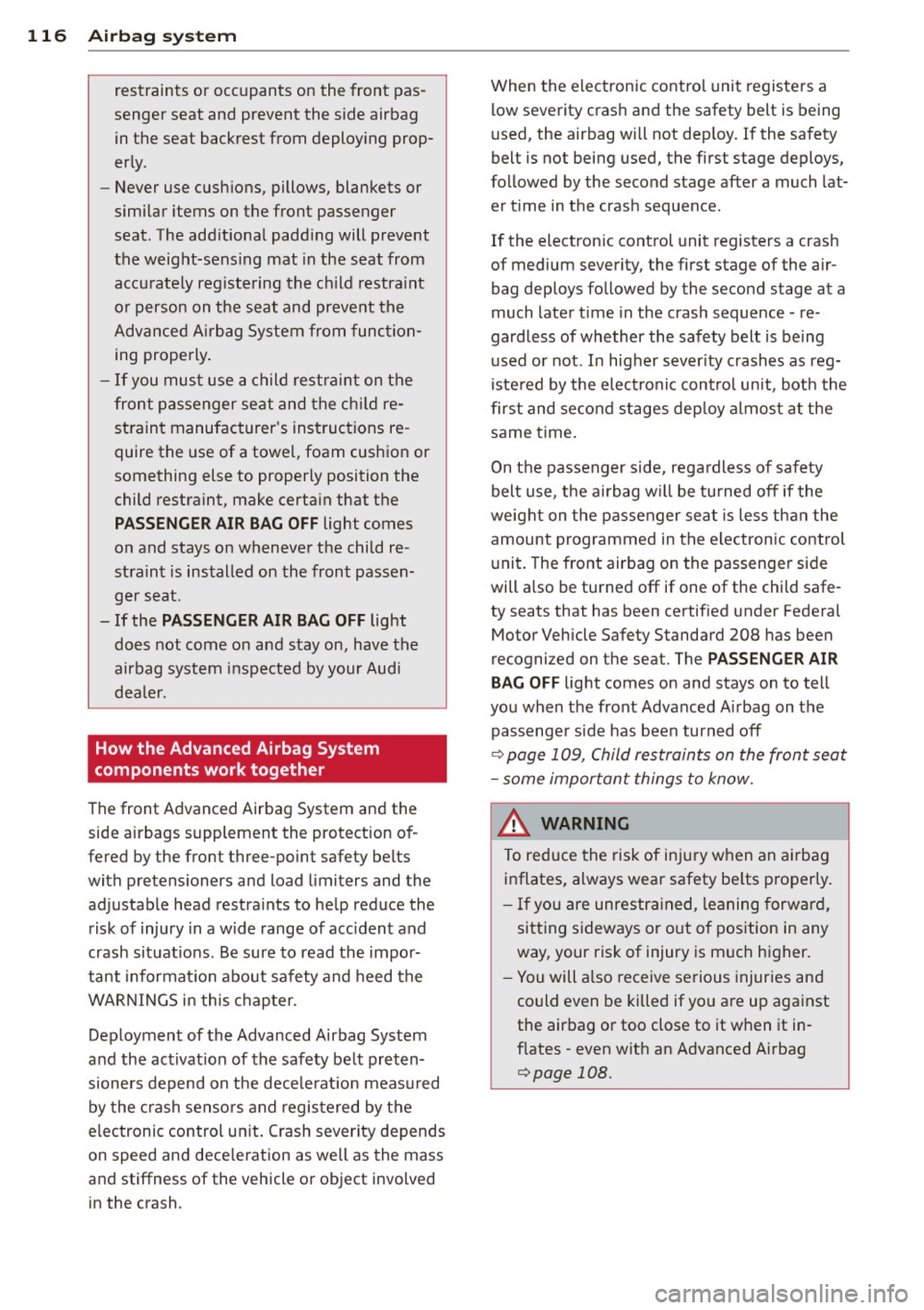
116 Airbag sys te m
res traints or occupants on the fr ont pas
senger seat and prevent the sid e airbag
in t he seat backrest from deploying prop
erly.
- Never use cushions, pillows, blankets or
similar items on t he front passenger
seat . The add itional padd ing will prevent
the weight-sensing mat in the seat from
accurately reg istering the ch ild restra int
or person on the seat and prevent the
Advanced Airbag System from function ing properly .
- If you mus t use a child restra int on the
front passenger seat and the ch ild re
straint manufacturer's instructions re
quire the use of a towel, foam cushion or
something else to properly position the
child restraint, make certa in that the
PA SSENGER AIR BAG OFF light comes
on and stays on whenever the child re
st raint is installed on the front passen
ger seat .
- If the
PA SSENGER AIR BAG OFF light
does not come on and stay on, have the
airbag system inspected by your Audi
dealer.
How the Advanced Airbag System
components work together
The front Advanced Airbag System and the
side airbags s upplement the protection of
fered by the front three-point safety be lts
with pretensioners and load limiters and the
adjustab le head restra ints to he lp reduce the
risk of injury in a w ide range of acc ident and
crash situat ions . Be sure to read the impo r
tant information about safety and heed the
WARNINGS i n this chapter .
Deployment of the Advanced Airbag System
and the activat ion of the safety be lt preten
sione rs depend on t he dece le rat ion meas ured
by the c rash senso rs and regis tered by the
e lectronic control un it . Crash severity depends
on speed and dece leration as well as the mass
and stiffness of the vehicle o r object involved
in the crash. When the e
lectronic contro l unit registe rs a
low severity cras h and the safety belt is being
u sed, the airbag will not dep loy.
If the sa fety
belt is not being used, the first stage deploys,
followed by the second stage after a much lat er t ime in t he crash sequence.
If the electron ic contro l unit registers a crash
of medium severity, the first stage of the air
bag deploys followed by the second stage at a
much later time in the crash sequence -re
gardless of whether the safety belt is be ing
u sed or not . In higher sever ity c rashes as reg
i ste red by the elec tronic con tro l un it, bo th the
first and se con d stages dep loy almost at the
same t ime.
On the passeng er side, rega rdless of safety
belt use, t he a irbag w ill be tu rned off if the
we ight on the passenger seat is less th an the
amount programmed in the e lectronic control
u nit . The front airbag on the passenge r side
will a lso be turned off if one of the child safe
ty seats that has been certified under Federal
Motor Vehicle Safety Standard 208 has been
recogni zed on the seat . The
PASSENGER AIR
BAG OFF light comes on and stays on to tell
yo u when the front Advanced A irbag on the
passenge r side has been turned off
¢ page 109, Child restraints on the front seat
- some important things to know .
.&_ WARNING ~
To reduce the risk of in ju ry when an a irba g
inflates , always wear safety be lts p roperly.
- If you are unrestra ined, leaning forw ard ,
sitt ing s ideways or o ut o f position in any
way, your risk of injury is m uch higher.
- You will a lso receive se rious injuries and
could even be killed if you a re up against
the airbag or too close to it when it in
f lates - even with an Advanced A irbag
¢page 108.
Page 119 of 244
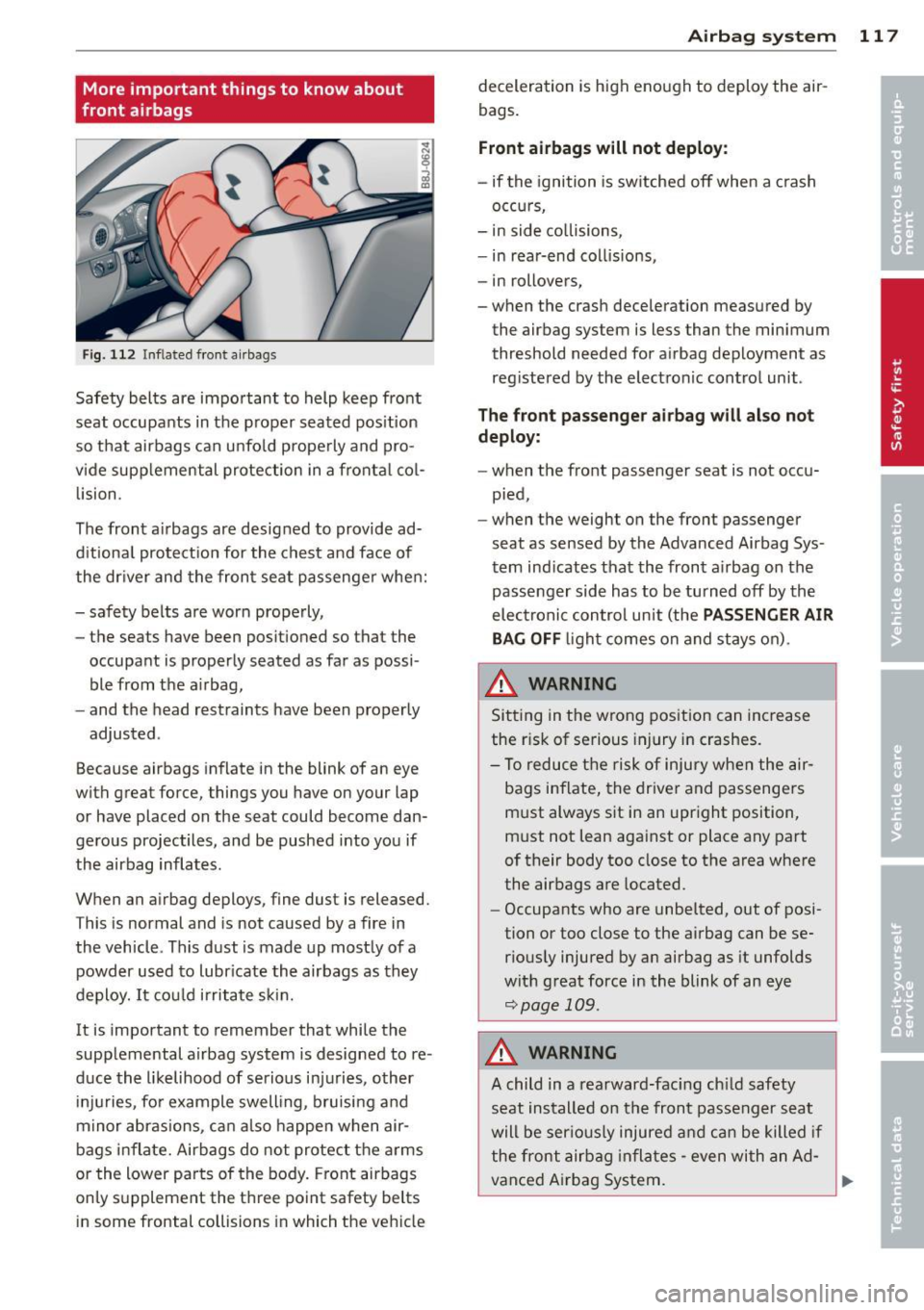
More important things to know about
front a irbags
F ig. 112 Inflated front airba gs
Safety belts are important to help keep front
seat occupants in the proper seated pos it ion
so that airbags can u nfold prope rly and pro
v ide supp lemental protection in a fronta l co l
lision .
The front a irbags are designed to provide ad
d itiona l protect io n for the chest and face of
the dr iver and the fron t seat passenger whe n:
- safety belts are wor n prope rly,
- the seats have been posit ioned so tha t the
occupant is proper ly seated as far as possi
ble from the a irbag,
- and the head restraints have been properly
adjusted .
Because airbags inflate in the blink of an eye
with great force, things you have on your lap or have placed on the seat could become dan
gerous projectiles, and be pushed into you if
the airbag inflates .
When an a irbag deploys, fine dust is released.
This is normal and is not caused by a fire in
the vehicle . This dust is made up most ly of a
powder used to lubr icate the airbags as they
deploy. It cou ld i rritate s kin .
It is important to remember that while the
supp lemental airbag system is designed to re
duce the likelihood of serious i njuries, other
inj uries, fo r example swell ing, bru isi ng a nd
minor abrasions, ca n also happen when air
bags inflate. Airbags do not protect the a rms
or the lower pa rts of the body. Front airbags
only s upplement the t hree point safety be lts
in some frontal collisions in which the vehicle
A irba g sy stem 11 7
deceleration is high eno ugh to deploy the air
bags .
Front airbags will not deploy :
-if t he ignition is sw itched off when a crash
occu rs,
- in side co llisions,
- in rear-end co llis ions,
- in rollovers,
- when the crash dece leration measured by
the airbag system is less than the minimum
threshold needed for a irbag deployment as
reg istered by the electronic con tro l unit .
The front pa ssenger airbag will also not
deploy:
- when the front passenge r seat is not occu
pied,
- when the weight on the front passenger
seat as sensed by the Advanced Airbag Sys
tem ind icates that the front a irbag on the
passenger side has to be tu rned off by th e
elec tronic con trol un it (the
PASSENGER AIR
BAG OFF
li ght comes on and st ays o n).
&_ WARNING ~
Si tti ng in the wrong pos ition can inc rease
the r isk of se rious in ju ry in crashes.
- To reduce t he ris k of injury when the air
ba gs inflate, the drive r and passenge rs
must always s it in an upr ight position,
m ust not lean against or place any part
of their body too close to the area whe re
the airbags a re located.
- Occupants who are unbe lted, out of posi
tion or too close to the airbag can be se rious ly injured by an airbag as it unfolds
with g reat force in the blink of an eye
~page 109 .
&_ WARNING
-
A child in a rearwar d-fac ing ch ild safety
seat installed on th e front passe nger seat
will be ser ious ly injured a nd ca n be killed if
the front ai rb ag inflate s - even wi th an Ad-
vanced Ai rbag Sys tem.
Ill-
Page 120 of 244
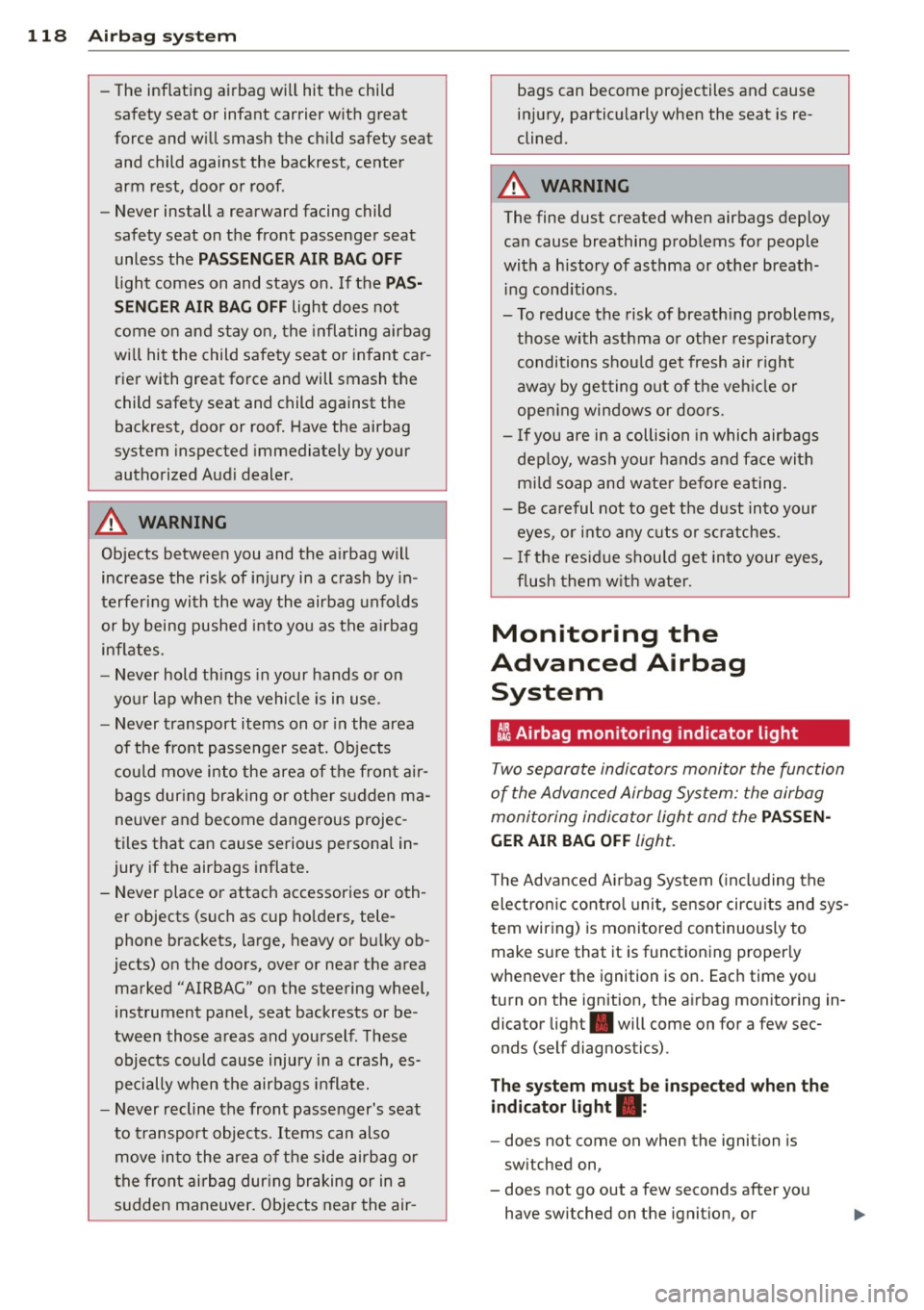
118 Airbag sys te m
- The inflating airba g will hit the child
safety seat or infant carri er w it h great
force and w ill smash the ch ild safety seat
and child against the backrest, cente r
arm r est, door or ro of.
- Ne ver install a r earward facing child
sa fety seat on the fro nt passenger seat
unl ess the
PASSENGER AIR BAG OFF
ligh t co me s on and stays on. If the PA S
SENGER AIR BAG OFF
ligh t does no t
come on and stay on, the inflating airbag
will hit the child safety seat or infant car
rier with great force and will smash the
child safety seat and child against the
backrest, door or roof. Have the airbag
system inspected immediately by your
authorized Audi dealer .
A WARNING
Objects between you and the a irbag will
increase the risk of injury in a crash by in
terfering with the way the airbag unfolds
or by being pushed into you as the a irbag
inflates.
- Never hold th ings in your hands or on
yo ur lap when the vehicle is in use.
- Never transport items on or in the area
of the front passenge r seat. Objects
c ou ld move into the area of the front air
bags dur ing braking or other s udden ma
neuver and become dange rous projec
tiles that can cause serious personal in
jury if the airbags inflate.
- Never place o r attach accessories or oth
er objects (such as cup ho lders, tele
phone brackets, large, heavy or b ulky ob
jects) on the doors, over or near the area
marked "AIRBAG" on the steering wheel,
instrument panel, seat backrests or be
tween those a reas and yourself. These
objects co uld cause injury in a crash, es
pecially when the airbags inflate.
- Never recline the front passenger's seat
to transport objects. Items can also
move in to the area o f the side airb ag or
the front airbag dur ing braking or in a
sudden maneuver. Objects near the air -
-
bags can become projectiles and cause
inju ry, partic ularly when the seat is re
clined.
A WARNING
The fine dust created when airbags deploy
can cause breathing prob lems for people
with a history of asthma or other breath
i ng cond itions.
- To reduce the risk of breath ing problems,
those with asthma o r othe r respiratory
conditions shou ld get fresh air righ t
away by getting o ut of the ve hicle or
open ing win dows or doors.
- I f you are i n a collision in which airbags
deploy, wash your hands and fa ce with
mild soap and wate r before ea ting.
- Be ca reful not to get the dust into your
eyes, o r into any c uts or s cratches.
- If the res id ue should get into your eyes,
flush them w ith wate r.
Monitoring the
Advanced Airbag System
tii Airbag monitoring indicator light
Two separate indicators monitor the function
of the Advan ced Airbag Sy stem: the airbag
monitoring indicator light and the
PASSEN
GER AIR BAG OFF
light.
T he Advanced A irbag Sys tem ( incl uding the
ele ctron ic cont rol unit, sensor circ uits and sys
tem wir ing) is monitored continuously to
make sure that it is functioning properly
whenever the ignition is on. Eac h time you
turn on the ignition, the a irbag monitoring in
dicator light . will come on for a few sec
onds (self diagnostics).
The system must be inspected when the
i ndicator light•=
-does not come on when the ignition is
sw itched on,
- does not go out a few seconds after you
have switched on the ignit ion, or